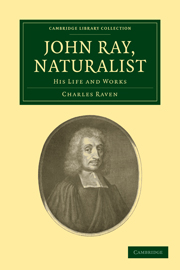Book contents
- Frontmatter
- Contents
- Preface
- Introduction
- ABBREVIATIONS
- Chapter I Boyhood and Youth
- Chapter II At Cambridge University
- Chapter III First Studies in Science
- Chapter IV The Cambridge Catalogue
- Chapter V The Years of Travel
- Chapter VI The English Catalogue
- Chapter VII The Years of Varied Output
- Chapter VIII The Structure and Classification of Plants
- Chapter IX The History of Plants
- Chapter X The Flora of Britain
- Chapter XI Last Work in Botany
- Chapter XII The Ornithology
- Chapter XIII The History of Fishes
- Chapter XIV Of Mammals and Reptiles
- Chapter XV The History of Insects
- Chapter XVI Of Fossils and Geology
- Chapter XVII The Wisdom of God
- Conclusion
- Index
Chapter XI - Last Work in Botany
Published online by Cambridge University Press: 07 September 2010
- Frontmatter
- Contents
- Preface
- Introduction
- ABBREVIATIONS
- Chapter I Boyhood and Youth
- Chapter II At Cambridge University
- Chapter III First Studies in Science
- Chapter IV The Cambridge Catalogue
- Chapter V The Years of Travel
- Chapter VI The English Catalogue
- Chapter VII The Years of Varied Output
- Chapter VIII The Structure and Classification of Plants
- Chapter IX The History of Plants
- Chapter X The Flora of Britain
- Chapter XI Last Work in Botany
- Chapter XII The Ornithology
- Chapter XIII The History of Fishes
- Chapter XIV Of Mammals and Reptiles
- Chapter XV The History of Insects
- Chapter XVI Of Fossils and Geology
- Chapter XVII The Wisdom of God
- Conclusion
- Index
Summary
Vir pius et modestus V.D.M. maximus ab hominum memoria botanicus…. Omnium botanicorum plurima opera edidit, uno Linnaeo excepto.
Albrecht von Haller, Bibliotheca Botanica, i, pp. 500, 506.Ray's work on the British Flora was only one comparatively small part of the output of the years after the publication of the Historia Plantarum. Busy as his life had been, no period of it was so productive as the years between 1688 and 1698; and hardly any writers can ever have produced so many and such varied books in a single decade.
Most of these publications deal with subjects other than botany. For as soon as his magnum opus was finished, he took up the task which Willughby had suggested and Robinson in his letter of 18 April 1684 had revived. The volumes in which he surveyed the Mammals, Reptiles, Birds and Fishes—those hand-books which he regarded as journeyman's work but which actually laid the foundations of zoological study—were finished in 1692 and 1694. They will be discussed in detail later. Here we need only remark that though the second of them, the Synopsis Avium et Piscium, was little more than a condensation of his two larger volumes, the first broke fresh ground and involved not only researches for which he had had little previous training, but the handling of general problems in biology and taxonomy in which he made new and very important contributions to learning.
- Type
- Chapter
- Information
- John Ray, NaturalistHis Life and Works, pp. 271 - 307Publisher: Cambridge University PressPrint publication year: 2009First published in: 1942



